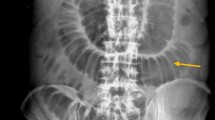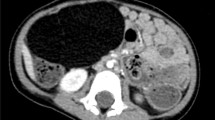Abstract
A 6-year-old boy with Bannayan-Riley-Ruvalcaba syndrome (BRRS) presented to the emergency department with periumbilical abdominal pain for 12 h. A contrast-enhanced abdominal and pelvis CT examination revealed significant interval change in the size and appearance of a previously seen hypoattenuating right mesocolic fatty mass suggestive for lipoma, first observed 5 months prior. This lesion demonstrated new enhancing internal septations, a thickened capsule, interval development of adjacent mesenteric fat stranding and engorgement of the mesenteric vessels. Given the short follow-up interval and acute clinical presentation, imaging findings were suggestive for torsion. We present this case for the unusual imaging findings as well as to highlight the differential diagnosis for abdominal fat containing lesions by imaging in patients with BRRS and other hamartomatous syndromes.




Similar content being viewed by others
References
Gorlin RJ, Cohen MM Jr, Condon LM et al (1992) Bannayan-Riley-Ruvalcaba syndrome. Am J Med Genet 44:307–314
Wolko JD, Rosenfeld DL, Lazar MJ et al (2003) Torsion of a giant mesenteric lipoma. Pediatr Radiol 33:34–36
Lynch NE, Lynch SA, McMenamin J et al (2009) Bannayan-Riley-Ruvalcaba syndrome: a cause of extreme macrocephaly and neurodevelopmental delay. Arch Dis Child 94:553–554
Grattan-Smith JD, Blews DE, Brand T (2002) Omental infarction in pediatric patients: sonographic and CT findings. AJR Am J Roentgenol 178:1537–1539
Pereira JM, Sirlin CB, Pinto PS et al (2005) CT and MR imaging of extrahepatic fatty masses of the abdomen and pelvis: techniques, diagnosis, differential diagnosis, and pitfalls. Radiographics 25:69–85
Moholkar S, Sebire NJ, Roebuck DJ (2006) Radiological-pathological correlation in lipoblastoma and lipoblastomatosis. Pediatr Radiol 36:851–856
Abubakar AM, Mayun AA, Pindiga UH (2009) Giant omental lipoma in a 13-year-old adolescent girl. J Pediatr Surg 44:2230–2232
Mendez-Uriburu L, Ahualli J, Mendez-Uriburu J et al (2004) CT appearances of intraabdominal and intrapelvic fatty lesions. AJR Am J Roentgenol 183:933–943
Conflicts of interest
None
Author information
Authors and Affiliations
Corresponding author
Rights and permissions
About this article
Cite this article
Laguna, B.A., Iyer, R.S., Rudzinski, E.R. et al. Torsion of a giant mesocolic lipoma in a child with Bannayan-Riley-Ruvalcaba syndrome. Pediatr Radiol 45, 449–452 (2015). https://doi.org/10.1007/s00247-014-3083-0
Received:
Revised:
Accepted:
Published:
Issue Date:
DOI: https://doi.org/10.1007/s00247-014-3083-0




